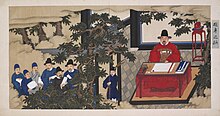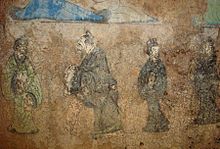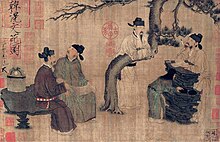Scholar-official
| |||||||||||||||||||||||||||||||||||||||||||||||||||||
Read other articles:

The following is a list of stadiums in Taiwan, ordered by capacity. Currently all stadiums with a capacity of 5,000 or more are included. Existing stadiums # Stadium Capacity City Tenants Image 1 National Stadium 55,000 Kaohsiung Chinese Taipei national football team, Taiwan Power Company F.C. 2 Taipei Dome 40,575 Taipei some Chinese Taipei national baseball team or Chinese Professional Baseball League (CPBL) matches 3 Tainan County Stadium 40,000 Tainan some local teams matches 4 Chungcheng Sta…

Japanese sumo wrestler (born 1841) Not to be confused with ōzeki Sakaigawa, his master.. In this Japanese shikona name, the surname is Sakaigawa. Sakaigawa Namiemon境川 浪右衛門Personal informationBornUdagawa Masakichi(1841-05-28)May 28, 1841Katsushika District, Shimōsa, JapanDiedSeptember 16, 1887(1887-09-16) (aged 46)Height1.68 m (5 ft 6 in)Weight128 kg (282 lb)CareerStableSakaigawaRecord118–23–6371 draws-5 holds (Makuuchi)DebutNovember, 1857Highest ra…

Untuk makanan lain dengan nama yang sama, lihat kelepon. Bola wijen biasa (kuning) dan bola wijen hitam Bola wijen kacang hijau Onde-onde[1] atau bola wijen (Hanzi: 煎堆; Pinyin: jiānduī; Yale (Bahasa Kanton): jīndēui) adalah sejenis kue jajanan pasar yang terkenal di Indonesia. Bola wijen mudah ditemukan di pasar tradisional maupun dijual di pedagang kaki lima. Bola wijen juga terkenal khususnya di daerah pecinan baik di Indonesia maupun luar negeri. Bola wijen terbuat…

Ираклеониты — ученики гностика Ираклеона (II век). Упоминаются как особая секта Епифанием и Августином; при крещении и миропомазании они соблюдали обряд помазания елеем и при этом произносили воззвания на арамейском языке, которые должны были освободить душу от власти �…

Jamaican-born poet, novelist, essayist and journalist (born 1941) Lindsay BarrettBarrett in 1983BornCarlton Lindsay Barrett (1941-09-15) 15 September 1941 (age 82)Lucea, JamaicaNationalityJamaican-NigerianOther namesEseogheneOccupation(s)Novelist, poet, playwright, journalist, broadcaster, photographerNotable workSong for Mumu (1967)RelativesA. Igoni Barrett (son) Carlton Lindsay Barrett (born 15 September 1941), also known as Eseoghene, is a Jamaican-born poet, novelist, essayist, pla…

Halaman ini berisi artikel tentang munisipalitas di India. Untuk distrik dengan nama yang sama, lihat Distrik Tawang. Pemandangan kota Tawang (bahasa Tibet: རྟ་དབང་) adalah ibu kota Distrik Tawang, Arunachal Pradesh bagian barat laut, India. Kota yang berada dekat perbatasan dengan Bhutan dan Republik Rakyat Tiongkok ini berpenduduk sekitar 4.500 jiwa. Patung Buddha Sakyamuni di Biara Tawang Dengan ketinggian sekitar 3.000 m dpl, Tawang dikenal akan Biara Galden Namgyal Lhatse …

Trilogia degli IlluminatiTitolo originaleThe Illuminatus! Trilogy AutoreRobert Shea e Robert Anton Wilson 1ª ed. originale1975 Generefantascienza, satira Sottogeneredistopia Lingua originaleinglese Modifica dati su Wikidata · Manuale La Trilogia degli Illuminati (The Illuminatus! Trilogy o anche Illuminatus!)[1][2][3] è una trilogia di romanzi scritti da Robert Shea e Robert Anton Wilson originalmente pubblicati a partire dal 1975,[4] riuniti nel 1984 in u…

OudenaardeMunicipalityOudenaarde Town Hall BenderaLambang kebesaranLocation of Oudenaarde Negara BelgiaMasyarakatMasyarakat FlandriaDaerahDaerah FlandriaProvinsiFlandria TimurArrondissementOudenaardePemerintahan • Wali KotaMarnic De Meulemeester (VLD) • Partai penguasaVLD, CD&V-N-VALuas • Total68,92 km2 (2,661 sq mi)Populasi (2022-01-01)[1] • Total31.866 • Kepadatan4,6/km2 (12/sq mi)Kode po…

「俄亥俄」重定向至此。关于其他用法,请见「俄亥俄 (消歧义)」。 俄亥俄州 美國联邦州State of Ohio 州旗州徽綽號:七葉果之州地图中高亮部分为俄亥俄州坐标:38°27'N-41°58'N, 80°32'W-84°49'W国家 美國加入聯邦1803年3月1日,在1953年8月7日追溯頒定(第17个加入联邦)首府哥倫布(及最大城市)政府 • 州长(英语:List of Governors of {{{Name}}}]]) • …

Person raised in a culture other than that of their parents Third culture kids (TCK) or third culture individuals (TCI) are people who were raised in a culture other than their parents' or the culture of their country of nationality, and also live in a different environment during a significant part of their child development years.[1] They typically are exposed to a greater volume and variety of cultural influences than those who grow up in one particular cultural setting.[2] Th…

American judge and politician George Foster ShepleyJudge of the United States Circuit Courts for the First CircuitIn officeDecember 22, 1869 – July 20, 1878Appointed byUlysses S. GrantPreceded bySeat established by 16 Stat. 44Succeeded byJohn LowellMilitary Governor of RichmondIn officeApril 3, 1865 – July 3, 1865Preceded byJoseph C. Mayo (Mayor)Succeeded byDavid J. Saunders Sr. (Mayor)18th Governor of LouisianaIn officeJuly 2, 1862 – March 4, 1864Prece…

Untuk kegunaan lain, lihat Nusantara (disambiguasi). NusantaraIbu Kota TerencanaIbu Kota NusantaraKawasan Titik Nol Ibu Kota Nusantara LambangMotto: Kota Dunia untuk SemuaPetaNegara IndonesiaDasar hukum pendirian UU Nomor 3 Tahun 2022 UU Nomor 21 Tahun 2023 Hari jadi18 Januari 2022; 2 tahun lalu (2022-01-18)Pemerintahan • BadanOtorita Ibu Kota Nusantara • Kepala OtoritaBambang Susantono • Wakil Kepala OtoritaDhony RahajoeLuas • Total…

Монастир Пива Manastir Piva 3.jpg 43°06′36″ пн. ш. 18°49′06″ сх. д. / 43.11000000002777455° пн. ш. 18.818611110027777755° сх. д. / 43.11000000002777455; 18.818611110027777755Координати: 43°06′36″ пн. ш. 18°49′06″ сх. д. / 43.11000000002777455° пн. ш. 18.818611110027777755° сх. д. / 43.1100000000277745…

Branch of American conservatism (c. 1910–1950s) This article is part of a series onConservatismin the United States Schools Compassionate Fiscal Fusion Libertarian Moderate Movement Neo Paleo Progressive Social Traditionalist Principles American exceptionalism Anti-communism Christian nationalism Classical liberalism Constitutionalism Familialism Family values Federalism States' rights Judeo-Christian values Individualism Law and order Limited government Militarism Moral absolutism Natural law…

一中同表,是台灣处理海峡两岸关系问题的一种主張,認為中华人民共和国與中華民國皆是“整個中國”的一部份,二者因為兩岸現狀,在各自领域有完整的管辖权,互不隶属,同时主張,二者合作便可以搁置对“整个中國”的主权的争议,共同承認雙方皆是中國的一部份,在此基礎上走向終極統一。最早是在2004年由台灣大學政治学教授張亞中所提出,希望兩岸由一中各表的�…

British actor Not to be confused with George Harrison. This article has multiple issues. Please help improve it or discuss these issues on the talk page. (Learn how and when to remove these template messages) This biography of a living person needs additional citations for verification. Please help by adding reliable sources. Contentious material about living persons that is unsourced or poorly sourced must be removed immediately from the article and its talk page, especially if potentially libe…

2016 local election in England, UK 2016 Solihull Metropolitan Borough Council election ← 2015 5 May 2016 2018 → One third (17) seats to Solihull Metropolitan Borough City Council26 seats needed for a majority First party Second party Third party Party Conservative Green Liberal Democrats Seats won 32 10 6 Seat change 2 Popular vote 23,724 9,975 5,580 Percentage 47.71% 20.06% 11.22% Fourth party Fifth party Sixth party Party UKIP La…

Sporting event delegationUnited States at the2003 Pan American GamesIOC codeUSANOCUnited States Olympic CommitteeWebsitewww.teamusa.orgin Santo Domingo1–17 August 2003Flag bearerCarl Eichenlaub[1]MedalsRanked 1st Gold 117 Silver 80 Bronze 73 Total 270 Pan American Games appearances (overview)1951195519591963196719711975197919831987199119951999200320072011201520192023 The United States sent a delegation to 14th Pan American Games in Santo Domingo, Dominican Republic from August 1�…

سداسي الأضلاعمعلومات عامةالنوع مضلعالأضلاع ضلع — نقطة هندسيةترتيب الرؤوس قطعة مستقيمةمخمسسباعي الأضلاعتعديل - تعديل مصدري - تعديل ويكي بيانات الشكل سداسي منتظم. سداسي منتظم مع زواياه. في الهندسة الرياضية، السداسي أو المُسدَّسُ (بالإنجليزية: Hexagon) هو مضلع ذو ستّة أضلاع وس�…

This film-related list is incomplete; you can help by adding missing items. (August 2008) Cinema ofJapan List of Japanese films Pre-1910 1910s 1920s 1930s 1940s 1950s 1950 1951 1952 1953 19541955 1956 1957 1958 1959 1960s 1960 1961 1962 1963 19641965 1966 1967 1968 1969 1970s 1970 1971 1972 1973 19741975 1976 1977 1978 1979 1980s 1980 1981 1982 1983 19841985 1986 1987 1988 1989 1990s 1990 1991 1992 1993 19941995 1996 1997 1998 1999 2000s 2000 2001 2002 2003 20042005 2006 2007 2008 2009 2010s 201…








